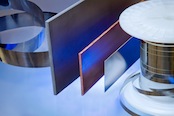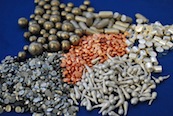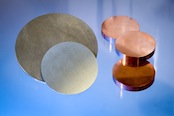Titanium Sulfide
MATERIAL SAFETY DATA SHEET
I. PRODUCT IDENTIFICATION
Manufacturer/Supplier:
ESPI Metals
1050 Benson Way, Ashland, OR 97520
Toll Free (800) 638-2581 * Fax (541) 488-8313
E-Mail: This email address is being protected from spambots. You need JavaScript enabled to view it.
Product Name: Titanium Sulfide
Formula: TiS2
CAS Number: 12039-13-3
II. HAZARDOUS INGREDIENTS
Hazardous Component: Titanate Sulfide
Percent (%): 0-100
OSHA/PEL: N/E
ACGIH/TLV: N/E
HMIS Ratings:
Health: 2
Flammability: 1
Reactivity: 1
III. PHYSICAL DATA
Boiling Point: N/E or N/A
Melting Point: N/E or N/A
Specific Gravity: 3.22 g/cc
Solubility in H2O: Hydrolyzes slightly
Appearance and Odor: Yellow to green powder, may have a slight sulfide odor.
IV. FIRE AND EXPLOSION HAZARDS DATA
Flash Point: N/A
Ignition Temperature: N/E or N/A
Explosive Limits: Lower: N/A Upper: N/A
Extinguishing Medium: Use suitable extinguishing media for surrounding material and type of fire.
Special Firefighting Procedures: Firefighters must wear full face, self-contained breathing apparatus with full protective clothing to prevent contact with skin and eyes. Fumes from fire are hazardous. Isolate runoff to prevent environmental pollution.
Unusual Fire and Explosion Hazards: When heated to decomposition, titanium sulfide may emit toxic fumes.
V. HEALTH HAZARD INFORMATION
Effects of Exposure:
Titanium and titanium compounds are considered physiologically inert. There are no reported cases in the literature where titanium as such has caused human intoxication.
Sulfides show variable toxicity. The alkaline sulfides are similar in action to alkalies. They cause irritation to the skin and are corrosive by ingestion. The heavy metal sulfides are generally insoluble and show little toxic action except through the liberation of hydrogen sulfide. Hydrogen sulfide, if generated, is toxic, a severe irritant and flammable. Effects include conjunctivitis, headache, nausea, dizziness, coughing, pulmonary edema and possibly death.
Acute Effects:
Inhalation: May cause irritation to the upper respiratory tract and mucous membranes.
Ingestion: No acute health effects recorded.
Skin: May cause skin irritation.
Eye: May cause irritation.
Chronic Effects: No chronic health effects recorded.
Medical Conditions Generally Aggravated by Exposure: Pre-existing respiratory disorders.
Carcinogenicity: NTP: No IARC: No OSHA: No
EMERGENCY AND FIRST AID PROCEDURES:
INHALATION: Remove the victim to fresh air, keep warm and quiet, give oxygen if breathing is difficult and seek medical attention.
INGESTION: Give 1-2 glasses of milk or water and induce vomiting, seek medical assistance. Never induce vomiting or give anything by mouth to an unconscious person.
SKIN: Remove contaminated clothing, brush material off skin, wash affected area with soap and water, seek medical attention if symptoms persist.
EYES: Immediately flush eyes with water, lifting upper and lower eyelids, for at least 15 minutes. Seek medical attention if symptoms persist.
VI. REACTIVITY DATA
Stability: Stable
Conditions to Avoid: Water/moisture.
Incompatibility: Strong acids, strong oxidizing agents and water/moisture.
Hazardous Decomposition Products: Titanium oxides, sulfur oxides and hydrogen sulfide.
Hazardous Polymerization: Will not occur.
VII. SPILL OR LEAK PROCEDURES
Steps to Be Taken in Case Material Is Released or Spilled: Wear appropriate respiratory and protective equipment specified in section VIII. Isolate spill area and provide ventilation. Vacuum up spill using a high efficiency particulate absolute (HEPA) air filter and place in a closed container for proper disposal. Take care not to raise dust.
Waste Disposal Method: Material should be disposed of in accordance with applicable Federal, State and Local regulations.
VIII. SPECIAL PROTECTION INFORMATION
Respiratory Protection: Wear a NIOSH/MSHA approved respirator.
Ventilation: Use local exhaust to maintain concentration of exposure at low levels. General exhaust is recommended.
Protective Gloves: Rubber gloves
Eye Protection: Safety glasses
Other Protective Equipment: Protective gear suitable to prevent contamination
IX. SPECIAL PRECAUTIONS
Precautions to Be Taken in Handling and Storing: Keep away from heat and moisture. Store the material in a sealed container.
Work Practices: Implement engineering and work practice controls to reduce and maintain concentration of exposure at low levels. Use good housekeeping and sanitation practices. Do not use tobacco or food in work area. Wash thoroughly before eating and smoking. Do not blow dust off clothing or skin with compressed air. Maintain eyewash capable of sustained flushing, safety drench shower and facilities for washing.
DOT Regulations:
Hazard Class: 4.2
Identification Number: UN3174
Packing Group: III
Proper Shipping Name: Titanium disulfide
The above information is believed to be correct, but does not purport to be all inclusive and shall be used only as a guide. ESPI shall not be held liable for any damage resulting from handling or from contact with the above product.
Issued By: S. Dierks
Dated: September 2006

 ALLOYS
ALLOYS 





